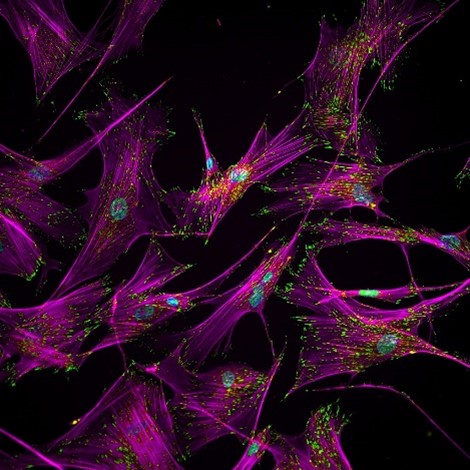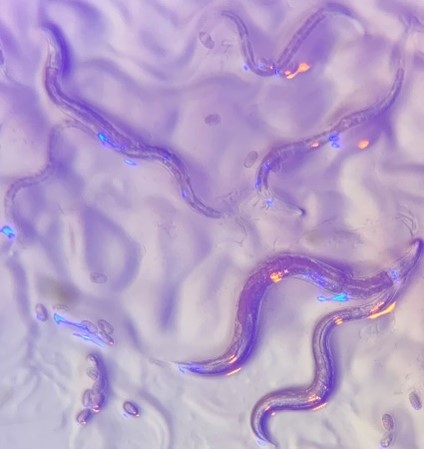To make naturally colorless biological structures easier to study, scientists often use fluorescent tags and other tools to color them. Here, we feature images with purple hues and pair them with questions to test your knowledge of basic science concepts.
Visit our image and video gallery for more scientific photos, illustrations, and videos in all the colors of the rainbow.
Results
Share...
Share...

#1. In this image, the blue spheres house most of the cells’ DNA. What are these spheres called?
The correct answer is B. Learn more about nuclei and other organelles by taking a tour of one of your cells.
Image Credit: Ankur Singh and Andrés García, Georgia Institute of Technology.
Share...

#2. This video shows a stress response in two cells where two proteins are labeled purple and green. The proteins appear between each cell’s membrane and nuclear envelope. What is that part of a cell called?
The correct answer is C. The cytoplasm includes the cytosol and all organelles except the nucleus. If you got that one right, and you’re feeling confident in your knowledge of cells, challenge yourself with this quiz.
Image Credit: Julia F. Riley, Heidi Hehnly, Sandra Hewett, and Carlos A. Castañeda, Syracuse University.
Share...

#3. The yeast cells in this image with blue lines in their middles are preparing to duplicate their DNA and split in two. What is this process called?
The correct answer is A. Mitosis is a type of cell division where the two newly formed cells are genetically identical to the parent. Check out more fascinating images and video of mitosis, or learn how the process works.
Image Credit: Maya Igarashi, Kathy Gould’s lab, Vanderbilt University.
Share...

#4. The purple threads in this image are strong, hollow fibers that provide structural support to cells. What are these fibers called?
The correct answer is D. Learn more about microtubules and the other parts of your cells’ cytoskeletons in this Science Snippet.
Image Credit: Melina Gyparaki, Melike Lakadamyali’s lab, Perelman School of Medicine at the University of Pennsylvania..
Share...

#5. The microscopic roundworms (Caenorhabditis elegans) shown in this image are used by scientists to study basic life processes. What does that make the roundworms?
The correct answer is A. Test your knowledge of research organisms with our quiz, or check out this collection of eye-catching C. elegans images.
Image Credit: Eugene L. Q. Lee, Massachusetts Institute of Technology.
Share...

This post is a great supplement to Pathways: The Imaging Issue.
The images in this post were captured using some of the techniques described in Pathways.
Learn more in our Educator’s Corner.










